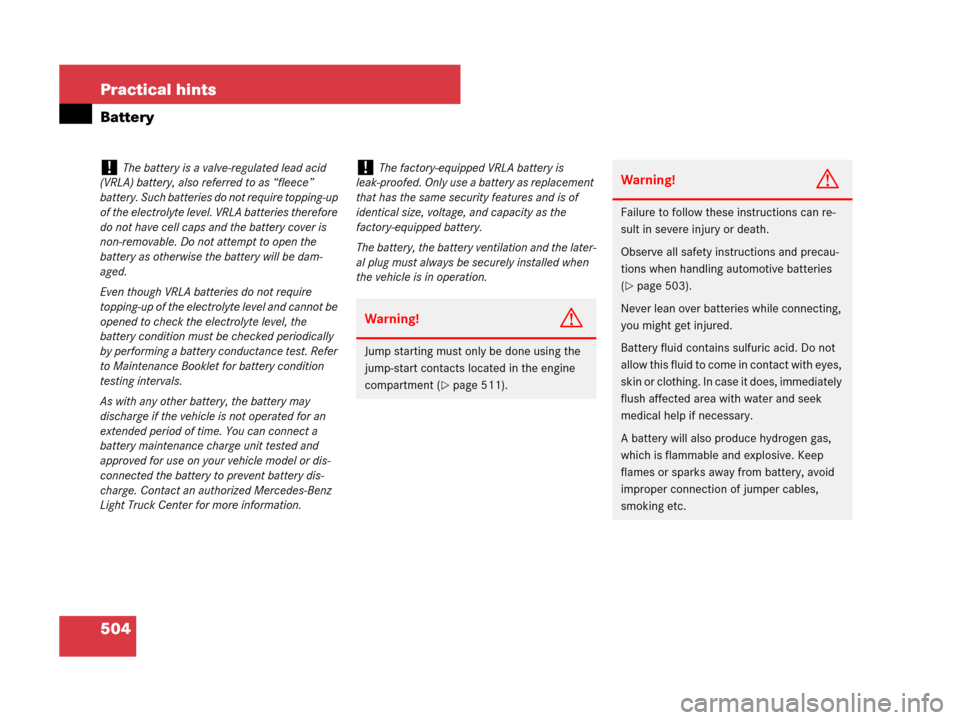Page 357 of 569

356 Operation
Engine compartment
Hood
Opening
Warning!G
Do not pull the release lever while the vehi-
cle is in motion. Otherwise the hood could
be forced open by passing air flow.
This could cause the hood to come loose
and injure you and/or others.
Warning!G
If you see flames or smoke coming from the
engine compartment, or if the coolant tem-
perature display indicates that the engine is
overheated, do not open the hood. Move
away from the vehicle and do not open the
hood until the engine has cooled.
If necessary, call the fire department.
Warning!G
You could be injured when the hood is open
– even when the engine is turned off.
Parts of the engine can become very hot. To
prevent burns, let the engine cool of com-
pletely before touching any components on
the vehicle. Comply with all relevant safety
precautions.
Warning!G
To help prevent personal injury, stay clear of
moving parts when the hood is open and the
engine is running.
The radiator fan may continue to run for
approximately 30 seconds or may even
restart after the engine has been turned off.
Stay clear of fan blades.
Warning!G
Vehicles with gasoline engine:
The engine is equipped with a transistor-
ized ignition system. Because of the high
voltage it is dangerous to touch any compo-
nents (ignition coils, spark plug sockets,
diagnostic socket) of the ignition system
�with the engine running
�while starting the engine
�if ignition is “on” and the engine is
turned manually
Page 505 of 569

504 Practical hints
Battery
!The battery is a valve-regulated lead acid
(VRLA) battery, also referred to as “fleece”
battery. Such batteries do not require topping-up
of the electrolyte level. VRLA batteries therefore
do not have cell caps and the battery cover is
non-removable. Do not attempt to open the
battery as otherwise the battery will be dam-
aged.
Even though VRLA batteries do not require
topping-up of the electrolyte level and cannot be
opened to check the electrolyte level, the
battery condition must be checked periodically
by performing a battery conductance test. Refer
to Maintenance Booklet for battery condition
testing intervals.
As with any other battery, the battery may
discharge if the vehicle is not operated for an
extended period of time. You can connect a
battery maintenance charge unit tested and
approved for use on your vehicle model or dis-
connected the battery to prevent battery dis-
charge. Contact an authorized Mercedes-Benz
Light Truck Center for more information.!The factory-equipped VRLA battery is
leak-proofed. Only use a battery as replacement
that has the same security features and is of
identical size, voltage, and capacity as the
factory-equipped battery.
The battery, the battery ventilation and the later-
al plug must always be securely installed when
the vehicle is in operation.
Warning!G
Jump starting must only be done using the
jump-start contacts located in the engine
compartment (
�page 511).
Warning!G
Failure to follow these instructions can re-
sult in severe injury or death.
Observe all safety instructions and precau-
tions when handling automotive batteries
(
�page 503).
Never lean over batteries while connecting,
you might get injured.
Battery fluid contains sulfuric acid. Do not
allow this fluid to come in contact with eyes,
skin or clothing. In case it does, immediately
flush affected area with water and seek
medical help if necessary.
A battery will also produce hydrogen gas,
which is flammable and explosive. Keep
flames or sparks away from battery, avoid
improper connection of jumper cables,
smoking etc.
Page 534 of 569
533 Technical data
Electrical system
�Electrical system
ModelR 3501
R 350 4MATIC
1USA only.
R 550 4MATIC2
2Canada only.
Generator (alternator)14 V/150 A14 V/180 A
Starter motor12 V/1.4 kW12 V/1.7 kW
Battery12 V/70 Ah12 V/95 Ah
Spark plugsBosch Y7MPP33NGK PLKR7A
Electrode gap0.031 in (0.8 mm)0.031 in (0.8 mm)
Tightening torque15 - 19 lb-ft (20 - 25 Nm)15 - 19 lb-ft (20 - 25 Nm)
ModelR 320 CDI 4MATIC
Generator (alternator)14 V/180 A
Starter motor12 V/2.0 kW
Battery12 V/95 Ah